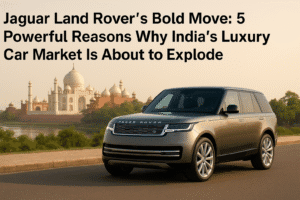Jaguar Land Rover’s Bold Move: 5 Powerful Reasons Why India’s Luxury Car Market Is About to Explode
Jaguar Land Rover (JLR) is accelerating its push in India’s luxury car market with plans to double sales and revenue by 2029, capitalizing on the country’s growing appetite for premium vehicles. The strategy hinges on local manufacturing—evidenced by its recent assembly of flagship Range Rover models in India—to reduce costs and align with the government’s “Make in India” initiative. JLR also aims to expand its dealership network to 50 outlets by 2030, targeting emerging cities like Rajkot and Nagpur, where rising wealth is fueling demand.
Electrification forms a key pillar, with the upcoming Range Rover BEV set to tap into India’s evolving EV infrastructure. The brand’s 40% sales surge in FY2025 (6,183 units) underscores its momentum, though competition from German rivals and gaps in charging networks pose challenges. As India’s luxury segment—currently ~50,000 annual sales—is projected to double in five years, JLR’s focus on personalization and SUVs positions it to carve a niche. This aggressive local strategy mirrors its parent company Tata Motors’ global £18B investment in electrification, signaling India’s growing role as both a market and a manufacturing hub for premium automotive innovation.

Jaguar Land Rover’s Bold Move: 5 Powerful Reasons Why India’s Luxury Car Market Is About to Explode
As India’s luxury car segment revs up, Jaguar Land Rover (JLR) is shifting gears with a bold plan to double its sales and revenue by 2029. This strategic push, anchored in local manufacturing, electrification, and an expanded retail footprint, positions JLR to harness India’s evolving appetite for premium vehicles. Here’s a deep dive into what’s driving this ambition and why it matters.
India’s Luxury Car Market: A Silent Growth Engine
While luxury vehicles account for just 1-2% of India’s 4-million-strong annual passenger vehicle market, the segment is quietly transforming. Rising disposable incomes, a surge in entrepreneurship, and aspirational spending among India’s affluent are fueling demand. JLR India’s Managing Director, Rajan Amba, notes the market is ripe for expansion: “The luxury segment, currently at ~50,000 units annually, could double in 4–5 years.” JLR’s 40% sales growth in FY2025 (6,183 units) already outpaces the broader sector, signaling strong brand resonance.
Four Pillars of JLR’s India Strategy
- Local Manufacturing: Cost Efficiency and “Make in India” Synergy
JLR’s decision to locally assemble flagship models like the Range Rover and Range Rover Sport marks a turning point. Local production cuts costs (critical in a price-sensitive market), avoids import tariffs, and aligns with India’s push for domestic manufacturing. This move also shortens delivery times, addressing a key pain point for luxury buyers accustomed to long waits for imported models.
- Electric Vehicles: Riding India’s Green Wave
JLR plans to introduce electric variants, including the highly anticipated Range Rover BEV, as India’s EV infrastructure gains momentum. Government incentives for EVs and rising eco-consciousness among affluent buyers make this a strategic bet. However, success hinges on addressing range anxiety and premium pricing—challenges JLR may counter with localized battery solutions or financing innovations.
- Doubling Dealerships: Tapping Tier 2-3 Cities
Expanding from 25 to 50 dealerships by 2030, JLR is targeting emerging hubs like Rajkot, Goa, and Nagpur. This reflects a broader trend: luxury brands are no longer limited to metros. Wealth generated in smaller cities, coupled with digital exposure, is creating demand for premium experiences closer to home.
- Hyper-Personalization: Catering to the Bespoke Obsession
Indian luxury buyers increasingly seek exclusivity. JLR’s emphasis on customizable interiors, bespoke trims, and limited editions caters to this desire for individuality—a differentiator in a market where rivals like Mercedes-Benz and BMW dominate volume sales.
Challenges on the Road Ahead
- Competition: German giants Mercedes, BMW, and Audi already command ~75% of India’s luxury market. JLR’s niche focus on SUVs and rugged luxury (via Defender) helps, but scaling requires broader appeal.
- EV Adoption: While promising, India’s EV charging network remains nascent. JLR’s EV rollout must align with infrastructure growth.
- Economic Sensitivity: Luxury demand is vulnerable to economic dips. A sustained upward trajectory relies on India’s macroeconomic stability.
Global Context: India as a Strategic Priority
Parent company Tata Motors’ £18B global investment in electrification and tech underscores JLR’s transition from traditional automaker to tech-driven luxury brand. India’s role here is dual: a high-potential market and a potential export hub. Recent U.S. tariff pressures further highlight the importance of diversifying JLR’s geographic reliance.
The Bigger Picture: What This Means for India
JLR’s strategy isn’t just about selling cars—it’s a vote of confidence in India’s luxury evolution. As local manufacturing scales, expect job creation in skilled sectors and tech transfer, particularly in EV components. Success could also inspire other luxury brands to deepen India commitments, fostering healthy competition and innovation.
Final Thoughts
JLR’s blueprint for India blends pragmatism and ambition. By localizing production, embracing electrification, and tapping into underserved cities, the brand is poised to capitalize on a market where luxury is no longer a niche but a statement of aspiration. However, navigating competition and infrastructure gaps will determine whether this British marque can truly dominate India’s luxury landscape. For now, the road ahead looks promising—and full of potential detours.
You must be logged in to post a comment.